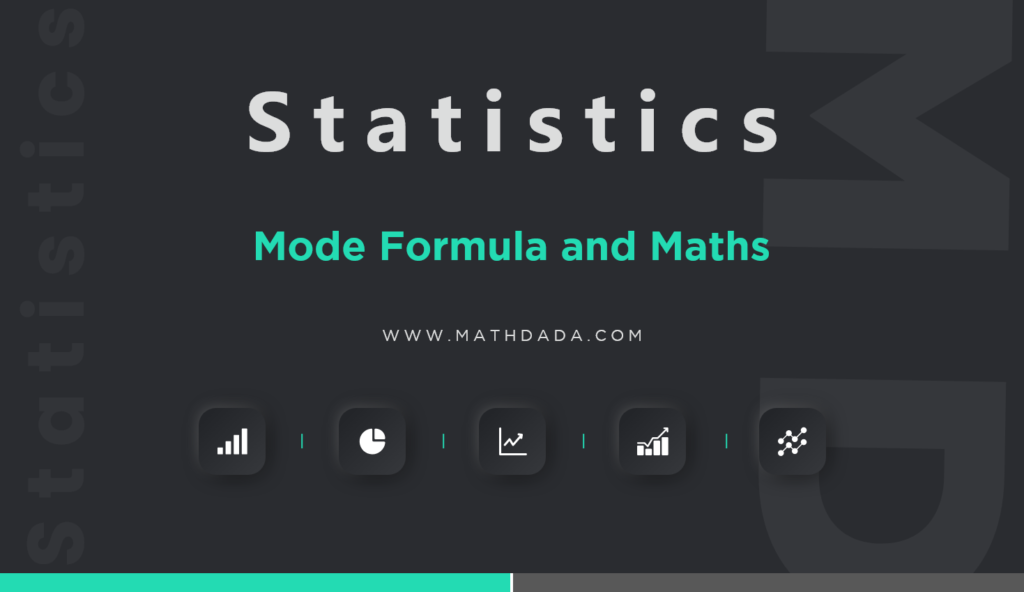Table of Contents
Mode
Here we will learn mode math using mode formula. It is the value which occurs with the maximum frequency. It is the most typical or common value that receives the highest frequency. It represents fashion and often it is used in business. Thus, it corresponds to the values of variable which occurs most frequently. The model class of a frequency distribution is the class with highest frequency. It is denoted by ‘z’.
If each observation occurs the same number of times, we can say that there is ‘no mode’. If occurrence of two observations is same, we say that it is a ‘Bi-modal’. If there are 3 or more observations that occurs the same number of times we say that ‘multi-modal’ case.
Calculation of Mode
Individual Series:
Inspection Method
In this case this method involves an inspection of the series. One is to simply identify the value that occurs most frequently in a series.
| Example |
Find the mode of the following data: 8, 10, 5, 8, 12, 7, 8, 9, 8, 11.
Solution:
Here in this series the value 8 occurs most frequently. Hence mode = 8.
Discrete Series:
In case of discrete series mode can be calculated by two methods
1. Inspection Method
2. Grouping Method
Inspection method
In this method, the value of mode is determined by inspecting the series. The value whose frequency is maximum, is the mode.
| Example |
Find out the mode from the following data:
| Income($) | 110 | 120 | 130 | 140 | 150 | 160 |
| No. of Persons | 2 | 4 | 8 | 10 | 5 | 4 |
Solution:
From the following series, the value 140 has the maximum frequency i.e., 10. Thus mode is 140.
Grouping Method
There may be cases when the value having the highest frequency may not be the modal value. This is the case when the difference between the maximum frequency and frequency preceding or succeeding it is very small. In such a case mode can be determined only by grouping method. This method consists of two tables – Grouping table and Analysis table.
Grouping Table
A grouping table has 6 columns
1. In column I, the maximum frequency is marked underlined or put in a circle
2. In column II, frequencies are grouped in tow’s, starting with the first two frequencies of the series.
3. In column III, first frequency is left out and the remaining are grouped in two’s.
4. In column IV, frequencies are grouped in 3’s starting with the first 3 frequencies.
5. In column V, leave the first frequency and group the remaining in 3 frequencies.
6. In column VI, leave the 1st and 2nd frequency and group the other frequency in 3’s.
The maximum frequency in each column is encircled.
Analysis Table
After preparation of grouping table we will prepare analysis table as follows:
1. Put the column number on the left hand side.
2. Put the probable value of the mode on the right hand side.
3. Now, enter into columns the highest frequencies marked in grouping table.
4. Take the total of each column to find out the value repeated maximum number of times. The value against which the total is highest is the mode.
| Example |
Find the mode by grouping method
| x | 7 | 8 | 9 | 10 | 11 | 12 | 13 | 14 | 15 | 16 | 17 |
| f | 2 | 3 | 6 | 12 | 20 | 24 | 25 | 7 | 5 | 3 | 1 |
Solution:
Group Table
| x | I | II (1+2) | III (2+3) | IV (1+2+3) | V (2+3+4) | VI (3+4+5) |
| 7 | 2 | 2+3=5 | 2+3+6=11 | |||
| 8 | 3 | 3+6=9 | 3+6+11=21 | |||
| 9 | 6 | 6+12=18 | 6+12+20=38 | |||
| 10 | 12 | 12+20=32 | ||||
| 11 | 20 | 20+24=44 | 12+20+24=56 | 20+24+25=69 | ||
| 12 | 24 | 24+25=49 | 24+25+7=56 | |||
| 13 | 25 | 25+7=32 | 25+7+5=37 | |||
| 14 | 7 | 7+5=12 | ||||
| 15 | 5 | 5+3=8 | ||||
| 16 | 3 | 3+1=4 | ||||
| 17 | 1 |
Analysis Table:
| Col. | 7 | 8 | 9 | 10 | 11 | 12 | 13 | 14 | 15 | 16 | 17 |
| 1 | ↗ | ||||||||||
| 2 | ↗ | ↗ | |||||||||
| 3 | ↗ | ↗ | |||||||||
| 4 | ↗ | ↗ | ↗ | ||||||||
| 5 | ↗ | ↗ | ↗ | ||||||||
| 6 | ↗ | ↗ | ↗ | ||||||||
| Total | 1 | 3 | 5 | 4 | 1 |
From the table the size 12 occurs the maximum number of times i.e., 5 times. thus the mode is 12.
Continuous Series:
In this method, first the modal group is find out either by using the inspection method or by grouping method. After determining the modal group mode can be found by using the following formula:
\[Mode=l+\frac{{{f}_{1}}-{{f}_{0}}}{2{{f}_{1}}-{{f}_{0}}-{{f}_{2}}}\times i\]
Where,
l = lower limit of the modal class.
f0 = frequency of the pre-modal class.
f1 = frequency of the modal class.
f2 = frequency of the post modal class.
i = size of the modal group.
Note:
1. If the 1st class is the modal class then is f0 taken as zero. Similarly, if the last class is the modal class then f2 is taken as zero.
2. Mean – Mode = 3 (Mean – Median) which is the same as, Mode = 3 Median – 2 Mode
| Example |
Praveen, an apartment builder, concerned about the number of customers who wishes to have plinth are of their apartment. He collects the data and summarises as shown in the following table. Find the modal plinth area.
| Plinth Are Sq ft | Number of Customers |
| 600-800 | 4 |
| 800-1000 | 10 |
| 1000-1200 | 15 f0 |
| 1200-1400 | 25 f1 |
| 1400-1600 | 12 f2 |
| 1600-1800 | 8 |
| Above 1800 | 2 |
Solution:
We note that the intervals are exclusive type and the highest frequency is 25. Therefore, the corresponding interval is 1200-1400, which is called modal class.
\[Mode=l+\frac{{{f}_{1}}-{{f}_{0}}}{2{{f}_{1}}-{{f}_{0}}-{{f}_{2}}}\times i\]
Where,
l = lower limit of the modal class = 1200
f0 = frequency of the pre-modal class = 15
f1 = frequency of the modal class = 25
f2 = frequency of the post modal class = 12
i = size of the modal group = 200
Therefore, the mode is calculated as:
\[Mode=1200+\frac{25-15}{2\times 25-15-12}\times 200=1200+\frac{2000}{23}=1286.95\]
Median |
Mean Median Mode |


